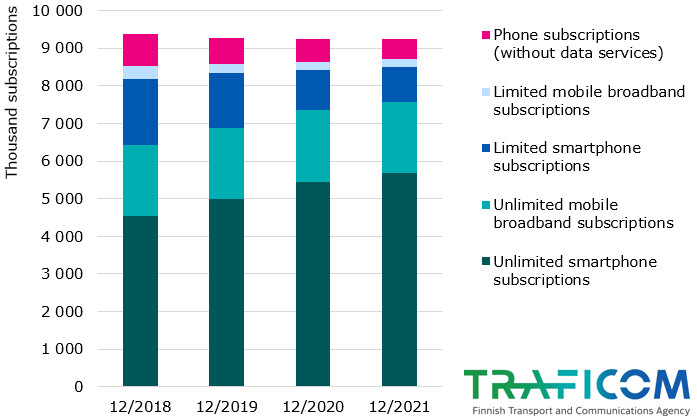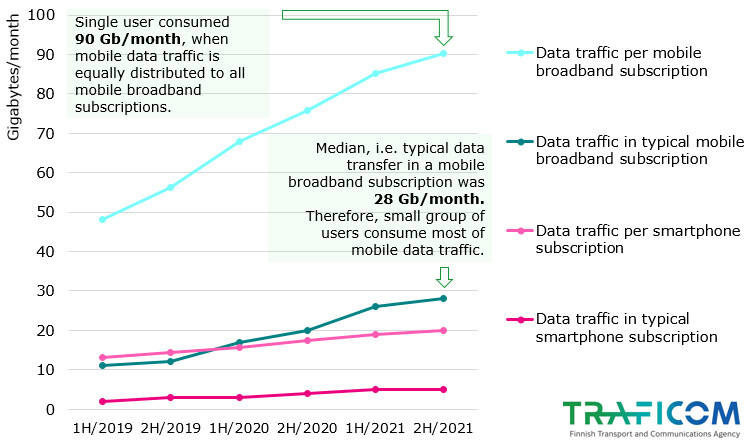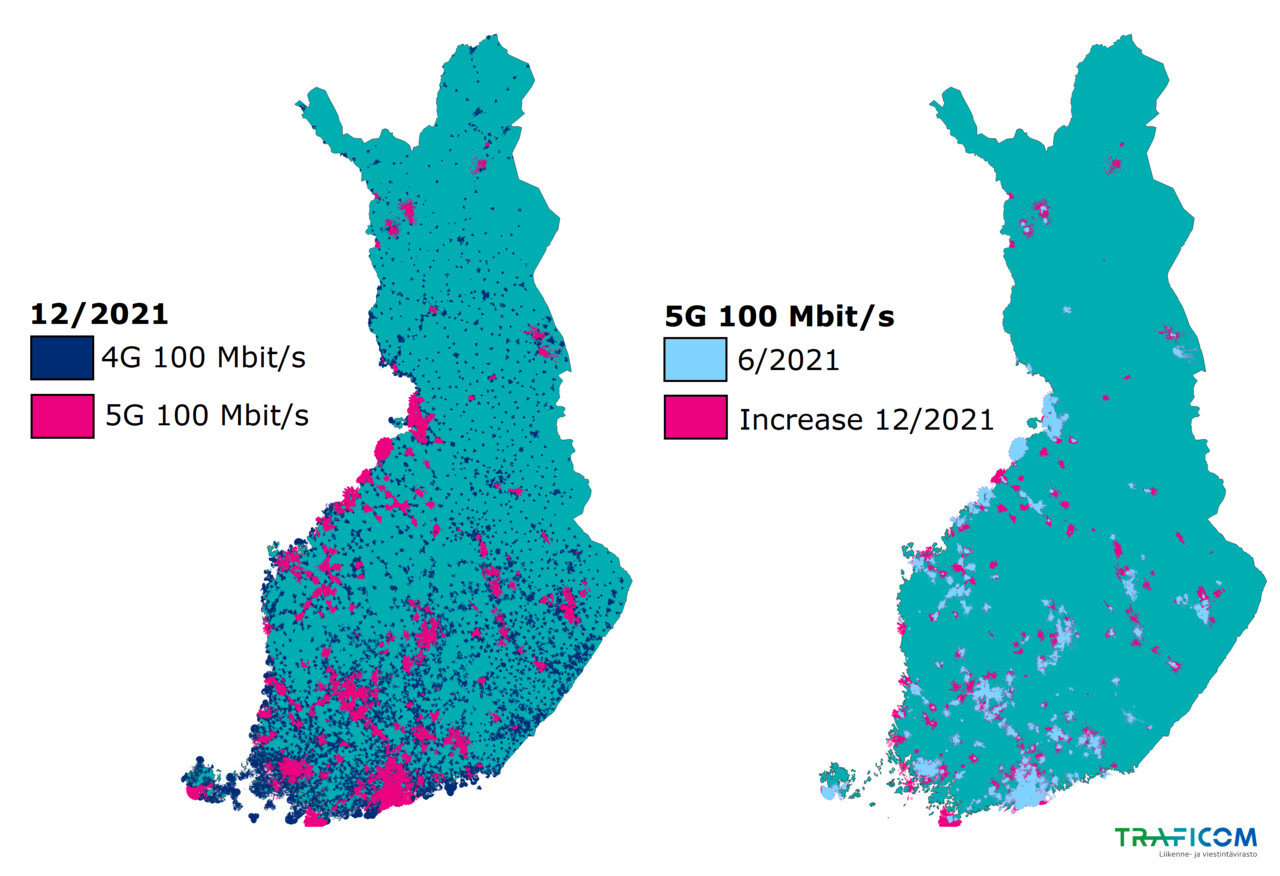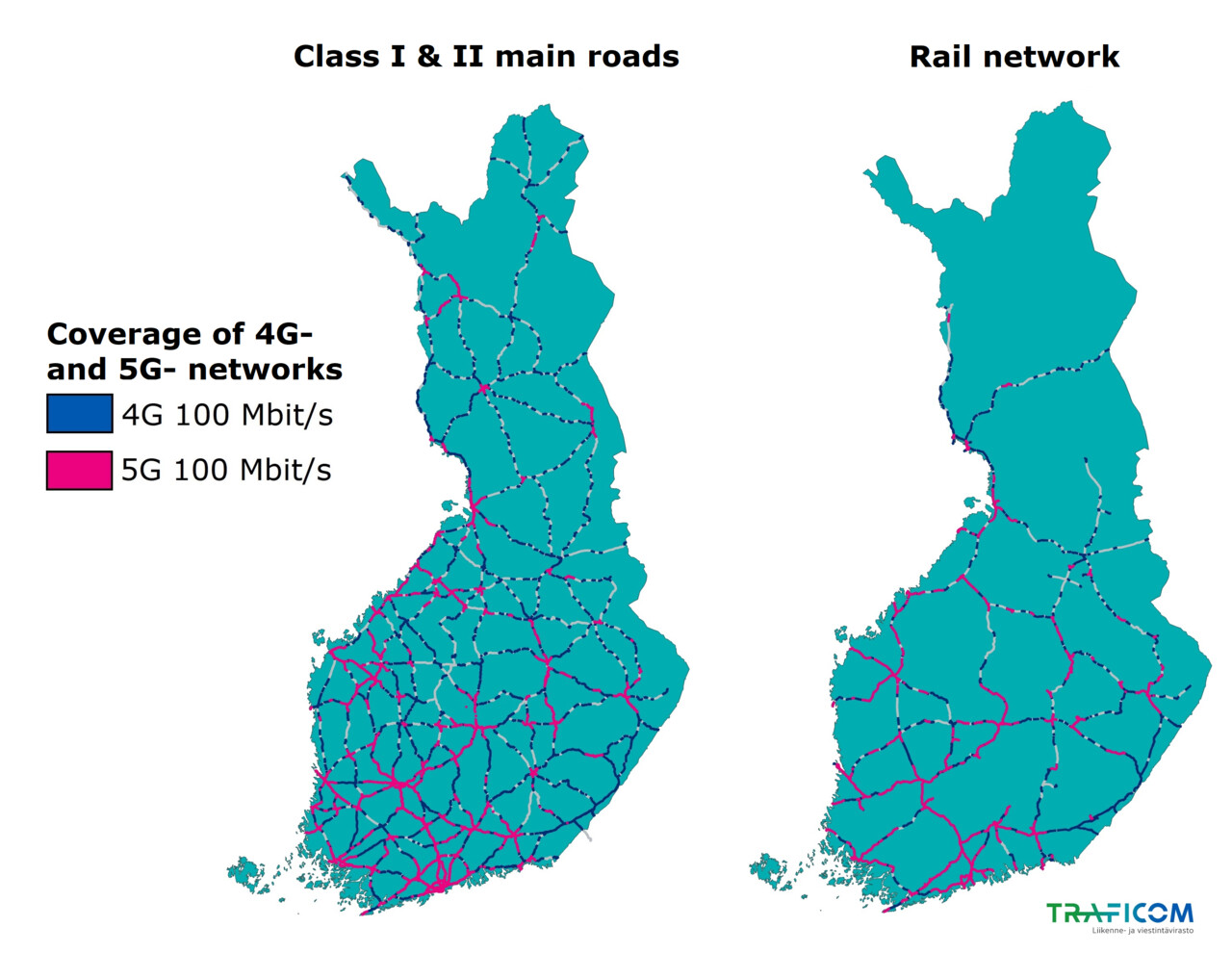The annual growth of data volumes transferred in Finnish mobile networks continues strong. In international comparison, the use of mobile connections in Finland is high. However, the use of mobile data is not evenly distributed among users – a small share of users use a major part of all data transferred. The coverage of the fast 5G network expanded significantly during last autumn: 5G already reaches more than 80 per cent of Finnish households. Improved coverage is expected to further increase data transfer volumes. The Finnish Transport and Communications Agency Traficom regularly collects information from telecommunications operators on the use and development of communications networks and services in Finland.
In 2021, 56 gigabytes (GB) of data was transferred in Finnish mobile networks per person in Finland. Five years earlier, the volume was 16 GB per month. Compared to other countries, people in Finland rely heavily on mobile networks as 43 per cent of Finnish households only use mobile connections. “This trend is due to good network coverage and subscriptions with unlimited data plans, which are less frequently used in other countries, at least in Europe. At the end of last year, the majority of mobile subscriptions in Finnish households included unlimited data plans for domestic data transfer. Only a few telecommunications operators even offer limited data plans,” says Marja Heinonen, communications market specialist at Traficom. The information is based on data collected from telecommunications operators at the end of 2021.
The number of voice-only mobile subscriptions with no data services was only slightly more than 500,000, and half of these subscriptions were used by businesses. The vast majority of active mobile subscriptions, nearly 7 million, included both voice and data services and were most likely used with smartphones. The number of so-called mobile broadband subscriptions, i.e. data-only subscriptions, amounted to more than 2 million at the end of last year. These subscriptions are used with tablets or 4G/5G home modems, for example. The number of SIM cards sold only for machine-to-machine communications (M2M subscriptions) was 1.5 million. These subscriptions are used with trail cameras or payment terminals in shops, for example.

Many homes only use mobile broadband
Because many access the internet via mobile networks both at home and on the move, the volume of data transferred per person in Finnish mobile networks is relatively enormous. Data is transferred especially via mobile broadband subscriptions, which accounted for 59 per cent of all mobile data transferred. “This figure also indicates that in many households mobile broadband is the only form of internet access, and the connection is used for gaming and watching TV series and movies, for example. These services require more data transmission than surfing the internet does. Data-heavy services are less frequently used with smartphones,” Heinonen says.
However, data transfer volumes per capita are not fully indicative. Traficom has also asked telecommunications operators to report median data transfer volumes per subscription and month to help us monitor consumption by ‘average users’. On average, subscriptions that include both voice and data plans (usually smartphone subscriptions) transferred 5 GB of data per month during autumn 2021 while the corresponding volume for mobile broadband subscriptions was 28 GB per month. These figures indicate that only a small share of users are responsible for a substantial part of all mobile data transmission and that data use is not evenly distributed across all users. Telecommunications operators usually enable users to monitor their use of mobile data, for example, by including the information on invoices or providing it via electronic or customer services. Depending on the device, information on data use may also be available via the device’s own user interface. This information helps users compare their own data use with the average figures indicated in the graph.

Fast 5G network available to more than 80 per cent of Finnish households
According to the statistics at the end of 2021, the coverage of the fast 5G network in Finland had expanded substantially, by 6 percentage points, covering already 82 per cent of Finnish households. In this context, fast network refers to a network with a download speed of at least 100 Mbps outdoors when not taking into account the effects of network congestion, obstacles in the natural or built environment or limitations due to the capacity of devices. Of all data in mobile networks, 4 per cent was transferred in the 5G network, which means that only a few users have so far started using subscriptions or devices supported by the 5G network despite the increase in 5G coverage. The fast 4G network, which is still being developed and improved, has for a while covered more than 90 per cent of Finnish households.

“The areas where Finnish households are located only cover a small part of the country’s total land area. Therefore, high household coverage does not mean high geographical coverage for the fast network, even though the mobile network is often used especially on the move,” says Communications Market Specialist Joonas Sotaniemi. At the end of the year, the fast 5G network covered 7 per cent of the total land area and fast 4G 18 per cent. In the future, there will be a growing need for access to fast networks along transport routes. At the end of 2021, the fast 4G or 5G network covered 62 per cent of main roads and highways and 64 per cent of the railway network.

To gain an understanding of the current situation and anticipate future needs, Traficom actively monitors the development of the digital infrastructure and digital services in Finland. This is done, for example, by gathering data from telecommunications operators on their subscription and usage volumes and mobile network coverages. The statistics presented above are based on this data and a 2021 consumer survey on the use of communications services.
ENQUIRIES AND MORE INFORMATION
Mobile network coverage by municipality and region (in Finnish)
Regional information in the Data.Traficom maps service (External link)
More communication statistics (External link) (in Finnish)
Marja Heinonen, Communications Market Specialist, tel. +358 29 539 0306, marja.heinonen@traficom.fi
Joonas Sotaniemi, Communications Market Specialist, tel. +358 29 539 0309, joonas.sotaniemi@traficom.fi (mobile network coverage)